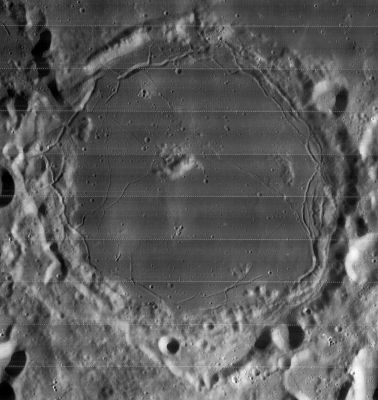Pitatus
Contents
Pitatus
|
Lat: 29.9°S, Long: 13.5°W, Diam: 106 km, Depth: 0.68 km, Rükl 54, Nectarian |

LO-IV-119-H3 processed by Stefan Lammel
Images
LPOD Photo Gallery Lunar Orbiter Images
Maps
(LAC zone 94C3) LAC map Geologic map
Description
Description: Elger
(IAU Directions) PITATUS.--This remarkable object, 58 miles in diameter, with Hesiodus, its companion on the W., situated at the extreme S. end of the Mare Nubium, afford good examples of a class of formations which exhibit undoubted signs of partial destruction, from some unknown cause, on that side of them which faces the Mare. On every side but the N., Pitatus is a walled plain of an especially massive type, the border on the S.W. furnishing one of the finest examples of terraces to be found on the visible surface. On the S.E., two parallel rows of large crateriform depressions, perhaps the most remarkable of their kind, extend for 60 miles or more to the E. flank of Gauricus. On the N.E., the rampart includes many curious irregular depressions and craters, and gradually diminishes in height, till, for a space of about 12 miles on the N., there can hardly be said to be any border at all, its site being marked by some inconsiderable mounds and shallow hollows. There is a small bright central mountain on the floor, and, S. of it, two larger but lower elevations. A distinct straight cleft traverses the N.E. side of the interior very near the wall, to which it forms an apparent chord, and a second cleft occupies a similar position with respect to the bright N.W. border. A narrow pass forms a communication with the interior of Hesiodus.
Description: Wikipedia
Additional Information
- Depth data from Kurt Fisher database
- Pike, 1976: 0.68 km
- Westfall, 2000: 0.68 km
- Cherrington, 1969: 0.88 km
- Central peak composition: A & GNTA1 (Tompkins & Pieters, 1999)
- Central peak height is 1.0 km Sekiguchi, 1972. - fatastronomer fatastronomer
- Tangential line of craters east of Pitatus (Gauricus M and Pitatus B, N, P & G) were interpreted by USGS mappers in the mid-60s to be volcanic,but now they are considered to be basin secondaries from the formation of the Imbrium Basin (N. Trask & S. Titley (1966) Summary of the Geology of the Pitatus Region of the Moon. in Astrogeologic Studies - Annual Progress Rpt, July 1, 1965-July 1, 1966, p. 6.
Nomenclature
- Pietro Pitati (in Latin, Petrus Pitatus) (?-fl. ca. 1550) was an Italian astronomer and mathematician. He was the author of several astronomical works and almanacs and a small tome on the nature of the Sun and the Moon.
- Pitatus Ray. This is a well known clair-obscur effect, appearing on the floor of Pitatus, always during local sunset circumstances. It is the opposite effect of the Hesiodus Ray during local sunrise. See also The Pitatus Lunar Ray, and APOD The Hesiodus Sunrise Ray.
LPOD Articles
Happy Thanksgiving
The Moon is not Green Cheese
Rings Within Rings
Awesome Pitatus
Sweet Pitatus
Smaller and Smaller Rilles
Lunar 100
L84: Crater with concentric rilles.
Bibliography
Wood, C.A. 1/2007. Concentric Fractures and Craters. S&T 113(1):71-72